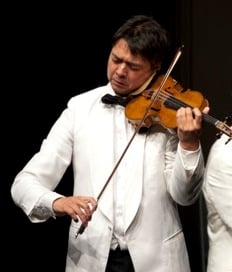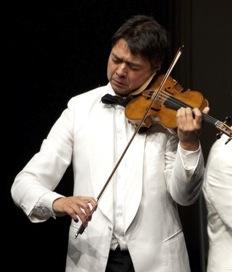MEMO
- To: That group of students who left Monday night’s recital at intermission, so they could get to Chipotle’s before it closed
- From: The audience at the S.F. Conservatory Caroline H. Hume Concert Hall
- Re: The relative richness and sustaining qualities of Dvořák’s Piano Trio No. 3 in F Minor, Op. 65, as performed by violinist Ian Swensen, cellist Tanya Tomkins, pianist Eric Zivian; and of a carnitas burrito

Yes, it’s true that we all have to eat. And Dvořák doesn’t come with chips and salsa. But in purely and memorably musical terms, the piece that occupied the second half of this Faculty Artist Series recital menu at the San Farncisco Conservatory of Music was a sumptuous, full-course meal. There were tension and high drama, witty outbursts and sly murmurs, flirtatious side conversations and ringing accords, glasses lifted to the light. It was everything, and more, that a good dinner party should be.
The evening’s headliner, violinist Ian Swensen, led the way with an impassioned, full-throated, and tightly focused performance. His sweet but driving tone ignited the combustive opening Allegro. Pianist Eric Zivian was in affirmative command, as well, dressing the table with those characteristic Dvořák dotted rhythms, concussive chords, and feathery runs. If cellist Tanya Tomkins got a little buried in all the bluster at first, she spoke up with some of the movement’s most tender and pointedly phrased lines when the air cleared a bit.
The exuberantly clomping Allegretto grazioso furnished a jaunty, boisterous episode. If the calmer trio section wobbled a bit, a showily exaggerated ritard ushered in a bright return to the movement’s A-theme material. The third movement, Poco adagio, elicited the most gorgeous playing of the night.
Everyone, musicians and audience alike, had been very well and fully nourished.Tomkins sang out with a voice that seemed all the more heartbreaking for its tactful restraint. Swensen lofted some exquisite airborne lines. And Zivian whirred it all together at the keyboard, deferring and asserting in responsive accord with his companions.
The closing Allegro was at once supple and propulsive, full of energizing momentum shifts, raucous playfulness, and lyrical effusions. It all rose to a grand false cadence, a gentle coda, and a final clattering flourish to finish it off. Everyone, musicians and audience alike, had been very well and fully nourished.
Trial by Fugue
Those burrito-seekers heard a very different sort of recital in the first half. Swensen, the evening’s headliner, opened with Bach’s unaccompanied Sonata No. 3 in C Major, BWV 1005. Things did not get off to a promising start, with a tentative and wayward Adagio marred by a scratchy tone and uneasy double stops. The prodigious Fuga that followed threatened to bury the piece entirely, but Swensen gathered himself and gained his footing midway through. A through line emerged amid all the complexity. The multiple voices balanced, counterbalanced, and blended. The midcourse applause seemed to acknowledge a successful trial by fugue-fire.
Then, after a serene but rather spartan Largo, Swensen made exhilarating quick work of the Allegro. Playing at breakneck speed, with every note cleanly and pleasingly hit, he ended the sonata in a giddy sprint. The boyish Swensen, who had stood very still when he played, jogged offstage.
What could have been tooth-achingly sweet was played to perfection.
With the Bach behind him, Swensen seemed to loosen up. He chatted with the audience, which included his Conservatory colleagues and students, about the second piece, Schoenberg’s Phantasy for Violin with Piano Accompaniment. In his engaging teacher mode, Swensen explained that the composer had written the entire violin part first, then added the piano accompaniment. In a brief piece that he described as “very romantic and expressive,” Swensen gave it his all.
Over Zivian’s terse and acerbic contributions, Swensen darted and swooned, plunged and plucked his way through Schoenberg’s 12-tone version of a rapturous fantasia. He found a tawny depth of sound and shimmered through his tremolos. For all the coiled tension of the music, Swensen himself seemed more at ease, bending and torquing his body into the music. That full-body commitment continued into the Dvořák.
For dessert, Swensen offered a single encore, Rachmaninov’s famous Vocalise. What could have been tooth-achingly sweet was played to perfection, with Zivian’s ably demure support. Instead of milking the composer’s longing phrases, Swensen spun them together into a great, long skein of melody. It was as if he’d sung the Vocalise without taking a breath.

